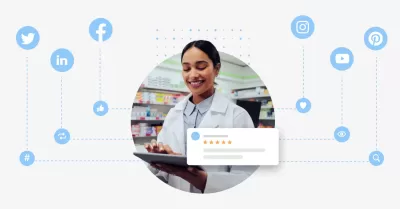Have you ever looked for any medical information online? Or are you a healthcare provider that sells medical products or services to patients and can’t quite figure out the best was to go about it ethically and in a way that gives you a good return on investment? If your answer is yes to either of the 2 questions, then this article is a double-edged sword because, as a patient or healthcare provider, you must understand the nitty-gritty of direct-to-patient marketing for positive outcomes.

Direct-to-patient (DTP) marketing is a strategy that allows healthcare organizations to reach their patients directly without going through intermediaries such as doctors or insurance companies. This approach can help healthcare providers build stronger relationships with their patients, improve patient satisfaction levels, and increase brand loyalty among consumers. Direct-to-patient marketing is becoming increasingly popular in the healthcare industry as patients are becoming more involved in their own healthcare decisions.
Direct-to-patient marketing encompasses a wide range of tactics, including television and print advertising, social media marketing, email marketing, content marketing, and patient education materials. The goal of these tactics is to engage patients and encourage them to take an active role in their healthcare decisions.
Suppose you’re a healthcare provider looking to implement a direct-to-patient marketing strategy. In that case, it’s important to understand who your target audience is and what channels they use to consume information. By understanding your audience and their preferences, you can create an effective omnichannel direct-to-patient marketing strategy that delivers results.
Strategies and Channels for Direct-to-Patient Marketing
When it comes to direct-to-patient marketing, there are several strategies and channels that can be used to reach your target audience. Here are some of the most effective ones:
Digital Platforms
Digital platforms such as search engines, social media, and online communities are great places to reach patients. You can use search engine optimization (SEO) techniques to ensure that your website ranks high in search results. You can also use paid search advertising to target specific keywords and demographics. Social media also forms part of the many digital platforms where you can engage patients in direct-to-patient marketing.
Social Media

Social media is a powerful tool for direct-to-patient marketing. You can use social media to share content, engage with patients, and build relationships. By creating a social media presence, you can increase your brand awareness and reach a wider audience.
Social media platforms such as Facebook, X, YouTube, TikTok, and Instagram are great places to share educational content, patient stories, and promotional offers, and to generally engage patients and build relationships. You can also use the many social media platforms to share helpful information, answer questions, and create a sense of community.
Email Campaigns
Email campaigns are a great way to reach patients directly. You can use email campaigns to share educational content, promote your services, and offer discounts. By building an email list, you can create a direct line of communication with your patients and keep them up-to-date with your latest news and offers. Make sure your emails are personalized, engaging, and targeted to ensure that they are effective.
Personalized Content
Personalized content is key to successful direct-to-patient marketing. By tailoring your content to your patients’ needs and preferences, you can create a more engaging and effective marketing campaign. You can use patient data to create personalized content that speaks directly to your patients’ concerns and interests. This can include personalized emails, social media posts, and website content.
Benefits of Direct-to-Patient Marketing

Direct-to-patient marketing has become increasingly popular in the healthcare industry due to its numerous benefits. By directly reaching out to patients, healthcare organizations can build stronger relationships with their patients, improve patient satisfaction levels, and increase brand loyalty among consumers. In this section, we will explore some of the key benefits of direct-to-patient marketing.
Improved Patient Outcomes
One of the most significant benefits of direct-to-patient marketing is improved patient outcomes. By providing patients with information about their health conditions and treatment options, healthcare organizations can empower patients to take an active role in their healthcare. This, in turn, can lead to better health outcomes and a higher level of patient satisfaction. Additionally, direct-to-patient marketing can help patients stay engaged with their healthcare providers, which can lead to better adherence to treatment plans and improved outcomes.
Brand Loyalty
Direct-to-patient marketing can also help healthcare organizations build brand loyalty among consumers. By providing patients with information about their products and services, healthcare organizations can establish themselves as trusted sources of information and build strong relationships with their patients. This can lead to increased patient loyalty and a higher level of brand recognition, which can be beneficial for healthcare organizations in the long run.
Market Expansion
Another key benefit of direct-to-patient marketing is market expansion. By targeting patients directly, healthcare organizations can expand their patient base and reach new markets. This can be particularly beneficial for healthcare organizations that are looking to grow their business and increase their revenue streams. Additionally, direct-to-patient marketing can help healthcare organizations stay competitive in a crowded marketplace by differentiating themselves from their competitors and establishing themselves as leaders in their field.

In summary, direct-to-patient marketing offers numerous benefits for healthcare organizations. By improving patient outcomes, building brand loyalty, and expanding their patient base, healthcare organizations can establish themselves as leaders in their field and provide patients with the information and resources they need to make informed healthcare decisions.
Challenges and Considerations in Direct-to-Patient Marketing
Direct-to-patient marketing is a powerful tool for healthcare providers to reach their patients and improve patient outcomes. However, there are several challenges and considerations that must be taken into account when implementing a direct-to-patient marketing strategy.
Privacy Concerns
One of the biggest challenges of direct-to-patient marketing is privacy concerns. Patients may feel uncomfortable with the idea of their personal health information being used for marketing purposes. It is important to ensure that patient data is collected and used in a responsible and ethical manner. Healthcare providers should be transparent about their data collection and use policies, and ensure that patients have the ability to opt-out of any marketing communications.
Information Overload
Another challenge of direct-to-patient marketing is information overload. Patients are bombarded with marketing messages from a variety of sources, and it can be difficult for them to distinguish between legitimate healthcare information and marketing hype. Healthcare providers should focus on providing patients with accurate, relevant, and actionable information that will help them make informed decisions about their health.

Cultural Sensitivity
Cultural sensitivity is also an important consideration in direct-to-patient marketing. Healthcare providers must be aware of cultural differences and nuances when developing marketing campaigns. What works in one culture may not work in another, and healthcare providers must be sensitive to these differences to avoid causing offence or alienating potential patients.
Impact of Technology on Direct-to-Patient Marketing
Direct-to-patient marketing has been transformed by technology, providing new opportunities for healthcare providers to reach their patients. Here are some of the technologies that have had the biggest impact:
Telehealth
Telehealth has become an increasingly popular way for healthcare providers to deliver care to their patients. It allows patients to connect with their doctors remotely, using video conferencing, phone calls, or messaging apps. Telehealth has been particularly useful since the COVID-19 pandemic, allowing patients to receive care without leaving their homes.
Mobile Health Apps
Mobile health apps are another technology that has had a big impact on direct-to-patient marketing. These apps allow patients to track their health and wellness, and receive personalized recommendations for improving their health. They can also be used to deliver targeted marketing messages to patients, based on their health data.
Wearable Devices
Wearable devices like fitness trackers and smartwatches have become increasingly popular in recent years. These devices can track a wide range of health data, from heart rate and sleep patterns to physical activity and stress levels. This data can be used to deliver personalized marketing messages to patients, based on their individual health needs.

Measuring the Success of Direct-to-Patient Marketing
When it comes to direct-to-patient marketing, measuring success is crucial to ensure that your efforts are yielding results. Here are some key measures that you should consider:
Key Performance Indicators
Key Performance Indicators (KPIs) are metrics that help you track the success of your marketing efforts. Some KPIs that you should consider include:
- Website traffic: Keep track of how many people are visiting your website. This is a good indicator of how well your marketing efforts are working.
- Conversion rate: This measures the percentage of visitors to your website who take a desired action, such as filling out a contact form or scheduling an appointment.
- Patient acquisition cost: This measures how much it costs to acquire a new patient. This can help you determine if your marketing efforts are cost-effective.
Patient Feedback
Patient feedback is another important measure of success. You can gather feedback through surveys, online reviews, and social media. This feedback can help you determine what patients like and don’t like about your marketing efforts or healthcare products and services. Use this information to refine your marketing strategy and improve patient satisfaction.
Return on Investment
Return on Investment (ROI) measures how much revenue your marketing efforts are generating compared to how much you’re spending on marketing. To calculate ROI, subtract your marketing expenses from your revenue and divide that number by your marketing expenses. This will give you a percentage that represents your ROI. A positive ROI means that your marketing efforts are generating more revenue than you’re spending. A negative ROI means that you’re spending more on marketing than you’re generating in revenue.

Overall, measuring success is critical to the success of your direct-to-patient marketing efforts. Use KPIs, patient feedback, and ROI to track your progress and make informed decisions about your marketing strategy.
Case Studies and Best Practices
Direct-to-patient marketing is a rapidly growing trend in the healthcare industry. It is a powerful tool that can help healthcare providers reach their target audience more effectively. In this section, we will explore some case studies and best practices that can help you develop a successful direct-to-patient marketing campaign.
Successful Campaigns
One of the most successful direct-to-patient marketing campaigns was launched by the pharmaceutical company Pfizer. The company used a combination of social media, email marketing, and mobile apps to reach patients with chronic conditions. The campaign was a huge success, with over 1 million patients signing up for the program.
Another successful campaign was launched by the healthcare provider Kaiser Permanente. The company used targeted email marketing to reach patients with specific health conditions. The campaign was highly effective, with a 60% open rate and a 20% click-through rate.
Industry Leaders
When it comes to direct-to-patient marketing, a few industry leaders stand out. One of them is WebMD. The company has a massive online presence and is known for providing accurate and reliable health information. WebMD has been successful in using its platform to reach patients with targeted marketing campaigns.

Another industry leader is the healthcare provider Mayo Clinic. Mayo Clinic has been successful in using social media to reach patients with its health information and services. The company has a large following on social media and has been able to build a strong brand presence online.
Innovative Approaches
Innovative approaches to direct-to-patient marketing can help you stand out from the crowd. One innovative approach is to use gamification. This involves using game-like elements to engage patients and encourage them to take an active role in their healthcare.
Another innovative approach is to use virtual reality. Virtual reality can be used to provide patients with an immersive experience that can help them better understand their health condition and treatment options.
In conclusion, direct-to-patient marketing can be an effective tool for healthcare providers. By using successful campaigns, learning from industry leaders, and adopting innovative approaches, you can develop a direct-to-patient marketing campaign that resonates with your target audience.
